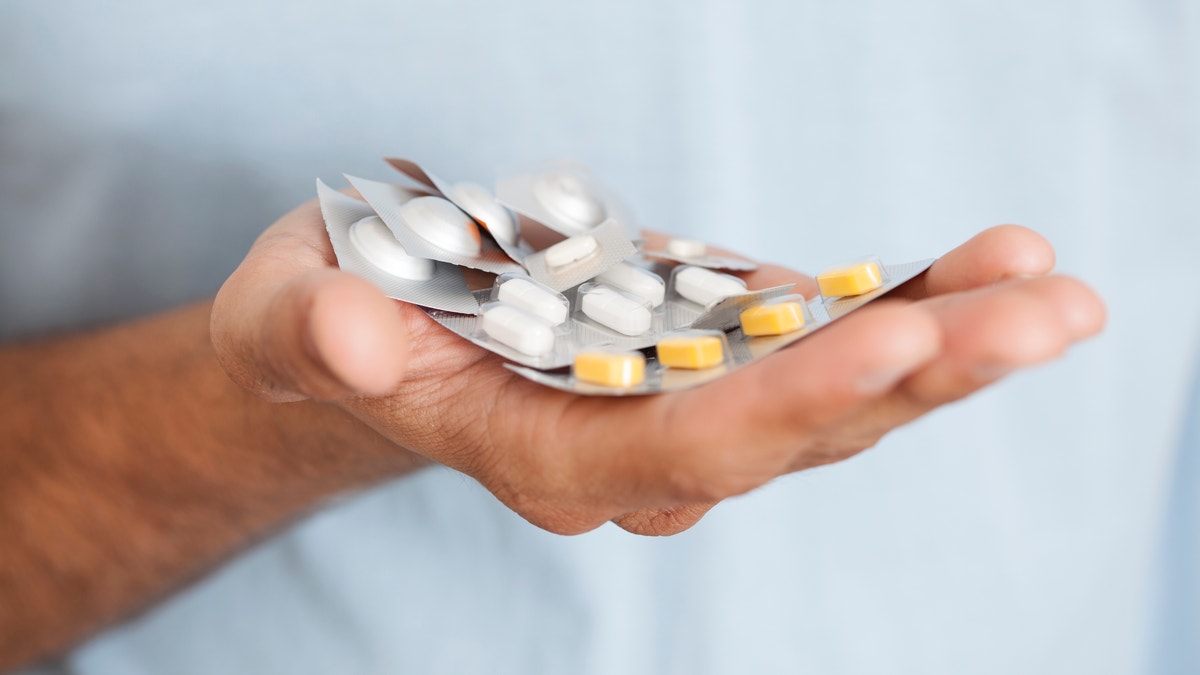
Unrecognised man holding stack of pills. (iStock)
Although he initially chalked up his symptoms to age, Wayne Masse decided to see his doctor about the fatigue, depression, hot flashes and sexual problems he had been dealing with.
“Erections weren’t as frequent or even as hard and of course that was starting to bother me,” the 56-year-old from Stouffville, Ontario said.
His doctor diagnosed him with low testosterone and put him on testosterone replacement therapy.
Like Masse, more men nowadays are thinking about testosterone hormone therapy as it seems to promise increased energy, happiness and a better sex life.
In fact, after one year of treatment, men 65 and older noticed an improvement in sexual function, mood and symptoms of depression, according to a study in The New England Journal of Medicine.
Experts agree however, that not only are more men asking for testosterone, but doctors also overprescribing it. Before you decide to start hormone therapy, here are nine things you should know.
1. It won’t give you stronger erections.
Up to 30 million men have erectile dysfunction, but the truth is that testosterone will only cause sexual frustration.
“Testosterone does not help a man get good erections. All it does is it increases his libido,” said Dr. S. Adam Ramin, a urologist and urologic surgeon at Cedars-Sinai Medical Center and the founder and medical director of Urology Cancer Specialists in Los Angeles.
2. You need a blood test.
Before starting testosterone replacement therapy, you need to undergo a complete hormone panel within two hours of waking up and then a repeat test within two to six weeks. This is to ensure that your levels are consistent because they can vary throughout the day or the lab could make a mistake, Ramin said.
Your doctor should test for total and free testosterone, sex hormone-binding globulin (SHBG), thyroid, estrogen, estradiol, progesterone, prolactin, a complete blood count (CBC) including hemoglobin and hematocrit to determine if testosterone is really low and the cause.
Although anything below 300 nanograms per deciliter (ng/dL) is considered low, realize that some doctors may prescribe treatment if it’s not at that level, Ramin said.
3. It’s not always about sex.
You might have symptoms of low testosterone, but experts agree that doesn’t necessarily mean you need to be on testosterone replacement therapy.
“Most of the time it’s about sex,” Dr. George M. Arnold, chief of OB-GYN, chief of clinical innovation and strategic ventures at Markham Stouffville Hospital in Ontario and Masse’s doctor said. “But often it ends up being far more than just that.”
In fact, low testosterone can be due to an iron deficiency or thyroid dysfunction. What’s more, a change in diet, exercise and sleep habits and stress reduction might be all that is needed to improve levels.
4. There can be side effects.
Testosterone replacement therapy is not without side effects.
When Masse’s estradiol—a form of estrogen—became elevated, the number on the scale started to creep up too.
“I couldn’t do anything not to gain weight. It was like I was gaining a pound every other week,” he said. To regulate his hormones, Arnold prescribed an aromatase inhibitor.
Testosterone replacement therapy can also cause the hemoglobin count to increase, something that can lead to blood clots and a pulmonary embolism. When blood clots form in the coronary arteries, and plaque is present, it can also lead to heart attack and stroke.
5. You can grow breasts.
Although it’s uncommon, testosterone replacement therapy can lead to breast development because testosterone can be converted to estrogen, which diminishes the effectiveness of testosterone.
Your doctor may prescribe an aromatase inhibitor but this too has to be monitored because if estrogen is too suppressed, it can make you feel fatigued, Arnold said.
6. You have options.
Testosterone replacement therapy is available as a gel, cream, patch, a tablet, as an injectable or an implant.
Testosterone is more effective as a cream or gel and studies show that the oral form can have a negative impact on the liver. However, it’s important to realize that what works for one person may not work for another, so a bit of trial or error may be necessary.
7. Your health could improve.
Testosterone replacement therapy can have a myriad of benefits when it’s used in the right candidate.
It can improve cognitive function and decrease or prevent the production of amyloid precursor protein, which leads to Alzheimer’s disease.
Replacement therapy is also associated with a reduced risk of insulin resistance, weight loss, increased muscle mass and feelings of positivity and happiness.
What’s more, studies show that a testosterone level in the mid-400s is protective against cardiovascular disease, but too high or too low and it could be dangerous, Ramin said.
8. It can make you infertile.
Testosterone replacement therapy can cause the testicles to atrophy and be unable to make enough testosterone and sperm, which could impact your fertility. If you’re on the therapy long-term, it could also impair your ability to produce the hormone naturally.
9. It doesn’t cause cancer.
There’s no clinical evidence that testosterone replacement therapy increases the risk for prostate cancer or benign prostatic hyperplasia, or prostate enlargement.
However, you must be screened for prostate cancer before starting testosterone replacement therapy. Although it doesn’t cause cancer, if you already have cancer it can cause it to grow faster and metastasize.
If you have already had prostate cancer, you must wait until you’re cancer-free— two to five years, depending on the disease’s aggressiveness— before starting therapy.
Although he had to go through several types of testosterone, Masse is happy and living his life to the fullest—biking, walking and having sex with his wife.
“I’m doing things that make me feel good again,” he said.




















